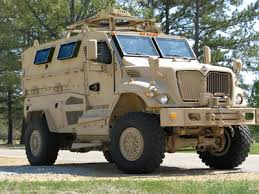Growing Unease about Local Police Agencies Employing Military Gear

March 27, 2015 - Homeland Security News Wire
A two-decade-old Pentagon program (the 1033 Program) makes available to state and local police military equipment that the military no longer wants. Without state or local oversight, state and local law enforcement, and even natural resources departments, can make requests through a designated state coordinator, who, with Pentagon officials, has final say on granting equipment requests. About $5.4 billion worth of equipment has been distributed since the program began in 1997. State lawmakers in many states want their states to have more of a say in what military gear law enforcement agencies in the state should get. Law enforcement in Florida requested, and received, forty-seven mine-resistant vehicles and thirty-six grenade launchers, while police in Texas received seventy-three mine-resistant vehicles and $24.3 million in aircraft.
The civil unrest in Ferguson, Missouri, last August after the killing of Michael Brown, an unarmed black teenager shot by a white police officer, brought to light the increasing militarization of police in America.
This more than a decade-old trend began with the 1033 Program, which makes available to state and local police Pentagon equipment that the military no longer wants. Without state or local oversight, law enforcement and even natural resources departments can make requests through a designated state coordinator, who, with Pentagon officials, has final say on granting equipment requests. About $5.4 billion worth of equipment has been distributed since the program began in 1997.
Stateline reports that now, eight months after the unrest in Ferguson between heavily armed police and protesters, lawmakers in Minnesota, California, Connecticut, Indiana, Montana, New Hampshire, New Jersey, Tennessee, and Vermont are trying to gain oversight over the 1033 Program.
State Senator Branden Petersen (R-Minnesota) wants to bar law enforcement in the state from accepting equipment “designed to primarily have a military purpose or offensive capability.” Earlier this month, New Jersey governor Chris Christie signed a bipartisan bill to increase local oversight of the 1033 Program; though Christie recently vetoed a separate bill that would have given the state’s attorney general oversight of the program. California lawmakers have introduced a bill that would give local governments a say over the equipment law enforcement can receive. A bipartisan bill in Tennessee would limit the type of offensive weapons law enforcement can receive, while another bill will provide more local oversight.
State Representative Nicholas Schwaderer (R-Montana) is sponsoring a bill that would require local authorities to notify citizens of any request for equipment- even a social media post would satisfy the requirement. Schwaderer said he has been alarmed by the way police forces have amassed equipment without input from the public. “This foundation sets a massive precedent in Montana and the country as to what kind of society we want to have,” Schwaderer said of his bill. “If you get to the point where you need a grenade launcher, we’ve got the National Guard.”
It remains to be seen whether any of the states will adopt measures close to New Jersey’s new legislation, but many lawmakers admit that they are facing opposition from law enforcement officials and the lawmakers who support them. “Our chiefs used the program to obtain both practical and tactical equipment. They called it a really vital resource for acquiring vital public safety tools especially in a time of tight budgets,” said Andy Skoogman of the Minnesota Chiefs of Police Association. He said police have repurposed many of the battlefield equipment for civilian law enforcement needs. “Those vehicles have been used to transport citizens, officers and equipment when the roads are closed due to snow, flooding and severe weather,” Skoogman said. “This program has really helped acquire key equipment.”
Pentagon press secretary Rear Adm. John Kirby defended the program last August saying, “Ninety-five percent of the property that is transferred to local law enforcement through this program is not tactical.” “It’s not weapons. It’s shelving, office equipment, communications gear, that kind of thing — furniture. I think it’s important to keep this thing in perspective.”
A Stateline analysis of the 1033 Program shows that U.S. states hold nearly $1.7 billion worth of equipment, an average of nearly $34 million per state. In Alaska, law enforcement 1033 Program equipment includes 165 rifles and almost $170,000 in night vision equipment, among other items. Law enforcement in Florida has forty-seven mine-resistant vehicles, thirty-six grenade launchers, and more than 7,540 rifles. Texas has seventy-three mine-resistant vehicles and a $24.3 million aircraft. Tennessee has thirty-one mine-resistant vehicles and seven grenade launchers, while North Carolina has sixteen helicopters and twenty-two grenade launchers.






